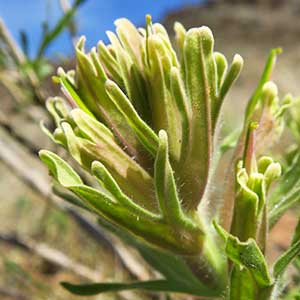Castilleja rupicola
Castilleja xanthotricha
cliff Indian paintbrush, cliff paintbrush
John Day or yellow-hairy paintbrush, John Day paintbrush, yellow hair paintbrush, yellow-hair Indian paintbrush
many, decumbent to ascending, unbranched, sparsely pubescent, hairs spreading, wavy, fairly short, soft, eglandular, sometimes glabrous proximally.
few to several, ± decumbent to erect or ascending, unbranched, sometimes with short, leafy axillary shoots, hairs erect to spreading, long, soft, eglandular, mixed with short stipitate-glandular ones.
purple to green, narrowly, rarely broadly, lanceolate, 1.4–4 cm, not fleshy, margins plane, flat to involute, (0–)3–5(–7)-lobed, apex acute to acuminate;
lobes divergent, spreading-ascending, linear, long, not much narrower than mid blade, often with secondary lobes, creating little frilly fans, apex acute or obtuse.
green, linear, lanceolate to broadly lanceolate, oblong, or cuneate, 0.8–5 cm, not fleshy, margins plane to wavy, involute, 0–5-lobed, apex acute, sometimes rounded;
lobes spreading, linear, arising below mid length, nearly as broad as center lobe, apex acute.
2–6 × 2–3.5 cm;
bracts proximally greenish or deep purple near base, distally red, scarlet, or crimson to red-orange, rarely orange, salmon, pink, or yellowish white, ovate to orbicular in outline, 5(–9)-lobed;
lobes spreading, linear to linear-lanceolate, long, arising below mid length, apex acute to rounded.
3–14 × 1.5–4.5 cm;
bracts proximally greenish, rarely dull reddish purple, distally white to cream, rarely pale yellow or dull, pale pink (sharply differentiated from proximal coloration), lanceolate or oblong to narrowly ovate, (3–)5–7-lobed;
lobes ascending, linear to obovate, ± broadened distally, medium, long, proximal lobes arising below mid length, central lobe apex broadly rounded to truncate, others acute to rounded.
straight or slightly curved, 25–35(–45) mm;
tube 9–15 mm;
beak exserted, adaxially green, purplish, or yellow-green, 14–22 mm;
abaxial lip deep green, reduced, 0.5–2 mm, 6–12% as long as beak;
teeth incurved to erect, green, 0.5 mm.
curved, 17–23 mm;
tube 15–19 mm;
beak exserted, adaxially green, 5–8(–9) mm, puberulent, stipitate-glandular;
abaxial lip deep purple (color sometimes visible through calyx), green, pinkish, or pale yellow, ± prominent, slightly inflated, usually hidden in calyx, sometimes right at top of calyx, 2 mm, ca. 50% as long as beak;
teeth ascending, whitish, yellowish, pink, or green, 1–1.5 mm.
proximally purple, green, or whitish, distally colored as bract lobes, 15–25 mm;
abaxial and adaxial clefts 8 mm, ca. 40–50% of calyx length, deeper than laterals, lateral 1–5 mm, 10–20% of calyx length;
lobes triangular, apex obtuse or acute.
colored as bracts, 15–26 mm;
abaxial and adaxial clefts 3.5–7 mm, 25–50% of calyx length, deeper than laterals, lateral 2–5 mm, 12–25% of calyx length;
lobes linear, oblong, or narrowly triangular, center lobe apex usually rounded, lobes acute to rounded.
= 48.
Castilleja rupicola
Castilleja xanthotricha
Castilleja rupicola is usually found in the subalpine and lower alpine zones in the Cascade Range from extreme southern British Columbia south to northern Douglas County, Oregon. Though it can be numerous where it occurs, the species as a whole is uncommon. One atypical population occurs in a moist, shaded, mossy, north-facing ravine on the Oregon side of the Columbia River Gorge, at less than 250 m. These plants often bear secondary divisions on deeply dissected leaves and bracts.
(Discussion copyrighted by Flora of North America; reprinted with permission.)
Castilleja xanthotricha is endemic to moderate elevations in the sagebrush hills of the John Day River drainage in north-central Oregon. N. H. Holmgren (1971) hypothesized that this tetraploid species is of allopolyploid hybrid origin between C. glandulifera and C. oresbia.
(Discussion copyrighted by Flora of North America; reprinted with permission.)



